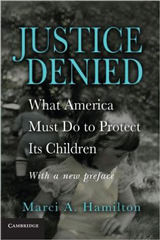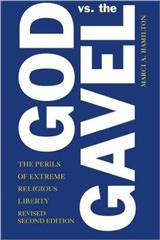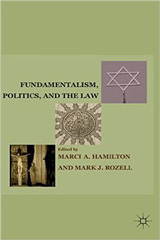It has taken over twenty years, but Congress is finally holding hearings to limit the impact of the toxic Religious Freedom Restoration Act, or RFRA, on civil rights. Two bills have been introduced in Congress that would carve back RFRA’s destructive reach, the Equality Act and the Do No Harm Act. Both focus on curtailing the capacity of RFRA to promote discrimination against LGBTQ, but the Do No Harm Act further limits the harm that RFRA engenders against the vulnerable, including children.
I am sincerely concerned about the false RFRA narrative that has taken over both sides of the debate over the Equality and Do No Harm Acts. The proponents of both Acts need to restart their arguments by tapping into the true story behind RFRA. You are making unnecessary concessions by whitewashing RFRA’s history, intent, and effect. Despite its title, RFRA did not “restore” actual case law. Rather, it introduced a license to lawlessness.
The false narrative that Trump actually won the 2020 election has been dubbed the “Big Lie.” It was an enormous misrepresentation to the American people that has led millions down a rabbit hole. Many ascribe this falsehood to Donald Trump, given his penchant for lying, but they are missing the big picture. His election Big Lie was built on the evangelization of lawlessness that has been operating against the public good since the Moral Majority gained political power. The righteous push for believers to be above the law, my friends, was sold to Congress and imposed on the American public by RFRA in 1993 and then, after the Court saved us from RFRA in Boerne v. Flores in 1997, again in 2000.
Donald Trump is a tool of the evangelical right, and he actually was riffing off of the foundation they laid with RFRA. RFRA was the first “Big Lie.”
The RFRA formula gives religious actors a right to be above the law that no other citizens enjoy. If a law “substantially burdens” you, the RFRA formula gives you the right to ignore that law unless the government can prove it serves a “compelling interest” in the “least restrictive means” possible. Good luck to the government. The original RFRA, passed in 1993, applied to every law in the country, local, state, and federal, legislative, executive, and judicial.
In the culture at the time, religious actors and entities were almost universally treated as both benign and benevolent. What could possibly go wrong if they weren’t penned in by the law like everyone else? The story was that the world would be a better place once believers were no longer yoked to legal restrictions in every context.
RFRA’s History Set Straight
As of 1990, litigators for the religious had been arguing for decades that their clients should not have to obey the laws that govern everyone else due to their faith. They argued that their clients shouldn’t have to pay taxes (United States v. Lee), abide by military uniform rules (Goldman v. Weinberger), observe limits on federal lands they didn’t own (Lyng v. Northwest Indian Cemetery Protective Association), or obtain social security numbers as part of the welfare system at the time (Bowen v. Roy). The Supreme Court routinely rejected these demands to be above the law, but they left standing legislative accommodations. The typical path was a challenge would be brought under the First Amendment’s Free Exercise Clause—the argument would be that the First Amendment placed them beyond the reach of the law—and the Supreme Court would reject it; then believers would seek legislative exemption. That happened in virtually every case. In other words, the Court held the line on constitutionalizing lawlessness, but deferred to lawmakers who considered the issue and created legislative exemptions to generally applicable laws.
The same story evolved after Employment Div. v. Smith, which is the decision that religious actors seized upon to secure a right to be above the law. In that case drug counselors argued the First Amendment protected their right to use an illegal drug as part of a religious service and, therefore, a right to obtain unemployment compensation after they were fired for using, peyote, an illegal drug (because they were drug counselors). The Supreme Court rejected their argument, consistent with prior case law. Indeed, the Justices viewed the claims, which were based on an expected right to violate both criminal and civil law, as arguments of first impression that were dangerous, as I documented here. In an opinion written by Justice Scalia, the Court majority accurately and thoroughly surveyed the Court’s doctrine to conclude two things: (1) the First Amendment does not create a right to overcome neutral, generally applicable laws that are not targeted at religious practices, and (2) the accommodation the petitioners sought was better achieved through the legislative process. What happened? Many states and federal government created exemptions for the religious use of peyote.
I was clerking for Supreme Court Justice Sandra Day O’Connor in 1990 when Smith was decided. As the case moved through the Court’s processes, no Justices or clerks were sounding an alarm about the end of religious liberty. Indeed, no one thought it was that remarkable. But not long after the decision was announced, those who had been trying to get the Court to agree to make believers above the law let loose. They gave up on the Court paving the way for them, and so turned to Congress.
The “Coalition for the Free Exercise of Religion” beguiled Congress with a bill brilliantly (though misleadingly) titled—the Religious Freedom “Restoration” Act—and a chance to be smarter than the Court on the Court’s own turf, interpretation of the First Amendment. For three years, hearings were held. They were short on examples as to why believers should be superior to the law, but there were many statements by lawmakers stating how awfully dim the Supreme Court was and how they would be the saviors of religious liberty.
The Coalition even drew liberal groups like the ACLU and People for the American Way into its snare. Remember: religious actors were benign and benevolent, so no harm could flow from giving them more rights. Thus, RFRA passed in 1993 via unanimous consent in the House (that is, there was no recorded vote) and by a vote of 96-3 in the Senate. This is the moment in history where you get the line about RFRA being “bi-partisan and passed nearly unanimously,” which is repeated on all sides. Well, not so fast.
The truth is that no one had a clue what had just been unleashed. The standard it set had not been part of the First Amendment’s doctrine, and the inherently “benign and benevolent” presumption about religiously motivated actors was false. The first major case pitted RFRA against a small Texas city’s historic preservation district, Boerne v. Flores. A church wanted to expand according to its own lights without having to abide by the preservation rules. I represented the City of Boerne, Texas, in its successful facial challenge to RFRA.
The Supreme Court Held RFRA Unconstitutional Because the Standard in RFRA Was Not the First Amendment Standard.
That word “Restoration” in RFRA was a really big lie, and the six-member majority said so. Justice Kennedy, writing for the Court, stated that it appeared “to attempt a substantive change in constitutional protections.” Indeed, RFRA’s “[s]weeping coverage ensures its intrusion at every level of government, displacing laws and prohibiting official actions of almost every description and regardless of subject matter. RFRA’s restrictions apply to every agency and official of the Federal, State, and local Governments. 42 U.S.C. § 2000bb-2(1). RFRA applies to all federal and state law, statutory or otherwise, whether adopted before or after its enactment. § 2000bb-3(a). RFRA has no termination date or termination mechanism. Any law is subject to challenge at any time by any individual who alleges a substantial burden on his or her free exercise of religion.” As I said in my brief to the Court, RFRA’s scope was “breathtaking.” The Court stated its standard led to a “likelihood of invalidation” of laws that were not discriminatory, but merely generally applicable.
By the time that RFRA was invalidated in 1997, its actual impact was becoming clearer. It was a tool that the right would want and the left should fear. For example, it didn’t take long for conservative apartment owners to argue that RFRA gave them the right to refuse to rent to unmarried couples in violation of fair housing rights that the left had fought to enact. The ACLU and People for the American Way started to edge away.
Following the Boerne decision, religious advocates returned to Congress to demand a RFRA redux, called the Religious Liberty Protection Act. I testified against it, because I saw it as a clear danger to civil rights, and every other law in the country. I raised Title VII as an example of a law that any RFRA could gut. In July 2000, we were told that the push for RFRA II was stalled and hearings would be scheduled for that fall. That’s when both houses passed the current RFRA via unanimous consent, the procedure with no roll call vote, and virtually no one in attendance. That’s right—it wasn’t passed “unanimously” at all. But it was bipartisan, because Democrats blinked, letting the unanimous consent process go forward, and handed to the Republicans a new RFRA, even though they knew for a fact that it would be wielded against federal civil rights.
As we have seen, RFRA is a menace to the civil rights of women (Burwell v. Hobby Lobby) and LGBTQ (Bostock v. Clayton County). Justice Gorsuch in Bostock correctly stated that RFRA is a “super statute” that will likely carve back on Title VII protections for LGBTQ.
The Cognitive Dissonance RFRA Injected into Religious Liberty Debates
But it is even more insidious, because RFRA has created a cognitive dissonance in our culture that is downright dangerous. The RFRA rhetoric and its misleading title have led to a widespread, but false, assumption that RFRA’s sui generis statutory rights are constitutional rights, as I elaborated in the Harvard Journal of Law and Public Policy.
This is, in fact, the first Big Lie: that RFRA was a mere “restoration” of constitutional standards, and that those standards create a preferred citizen class of religious believers who need not worry about the pesky law. RFRA was a radical change cloaked in false cultural presuppositions hidden by a misleading title and weaponized by members of Congress who couldn’t resist stepping into the Court’s domain. RFRA advocates—and this applies to the federal version and the state counterparts—want us to believe that the Constitution sanctions treating religious believers as above the law. No, it doesn’t, and it never should.
The critics of the Equality and Do No Harm Acts talk about their “constitutionally protected” and “First Amendment rights” being at risk. That is dangerous rhetoric. The exemption from RFRA that both Acts sanction is in fact a return of the religious liberty calculus to its constitutional foundation.
Just as millions of Americans have been misled into thinking that the 2020 election was “stolen” from Donald Trump, the same constituency was willingly misled into believing that the Constitution grants them a right to avoid all laws, and a transcendent right to impose their faith on others, including in the workplace and the marketplace. Yet, there is no such constitutional right to martyr others for your faith, thank God.
The Equality and Do No Harm Acts threaten religious triumphalism, but not wholesome religious liberty.









